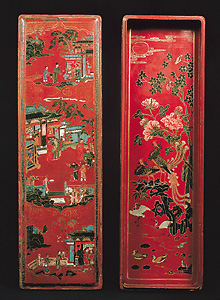Lacquerware is a decorative object made by coating an article, such as a box, dish, tray, or vase, with many layers of varnish. The varnish forms a durable, glossy, waterproof surface that can be painted, carved, or decorated in other ways. Varnishes used to make lacquerware include lacquer and shellac. They may be clear or colored. Some objects have 200 coats of varnish.

The art of making lacquerware developed in China, where lacquer probably was first produced. Chinese lacquer objects date from as early as 300 B.C. The Japanese learned the art from the Chinese, probably during the A.D. 500’s. In the early 1600’s, China and Japan began exporting lacquerware boxes, chests, cups, screens, and other items to Europe. European artists soon began making lacquerware, but they used shellac instead of lacquer. During the 1700’s, trade flourished in Europe for shellac-based European lacquerware. However, the finest lacquerware articles were still made in China and Japan.
